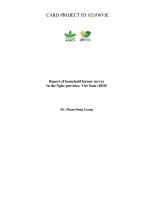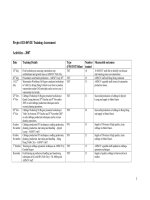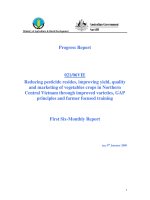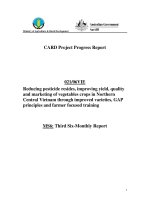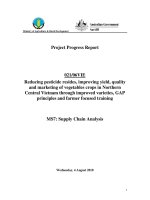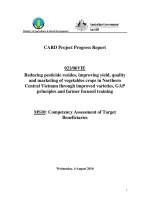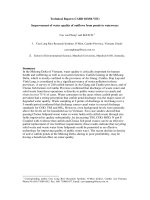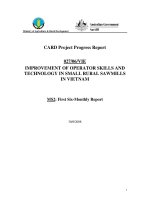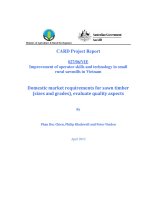Báo cáo khoa học nông nghiệp " Effects of Stocking Biomass on Growth, Survival and Production of the Two Sizes of Clam Meretrix lyrata Cultured in the Intertidal Areas And Notes on Hatchery Production of Clam Spat " pot
Bạn đang xem bản rút gọn của tài liệu. Xem và tải ngay bản đầy đủ của tài liệu tại đây (177.2 KB, 18 trang )
1
Ministry of Agriculture & Rural Development
Collaboration for Agriculture & Rural Development
(CARD)
027/05VIE
Effects of Stocking Biomass on Growth, Survival and
Production of the Two Sizes of Clam Meretrix lyrata
Cultured in the Intertidal Areas
And
Notes on Hatchery Production of Clam Spat.
Nhu Van Can
(*)(1)
, Chu Chi Thiet
(1)
and Martin S Kumar
(2)
(1) Aquaculture Research Sub-Institute for North Central (ARSINC)
(2) South Australian Research and Development Institute (SARDI), Australia
Paper presents in Workshop on “Better Aquaculture Practices”
Nha Trang, 7/2009
2
Abstract
This paper mainly focused on providing the impact of stocking biomass on the
production of clam. It also provides a brief on hatchery production of clam spat, one of
the key achievements which contributed towards better aquaculture practice.
The triplicate experiment had been conducted in 50m
2
plots randomly placed in the
intertidal areas to evaluate the effects of stocking biomass on survival, growth
performance and quality of clam Meretrix lyrata Sowerby, 1851. The two stocking sizes
(Mean±SD, cm) at shell length of 1.0±0.2 and 1.7±0.1 were scattered at different
biomass: 0.05, 0.1, 0.2, 0.3 kg.m
-2
and 0.34, 0.68, 1.36, 2.03 kg.m
-2
and named as T1, T2,
T3, T4 and T5, T6, T7, T8 respectively. Results shown that meat ratio of the clam were
similar regardless of different stocking biomass. The fatty acids were rich in highly
unsaturated fatty acids especially docosahexaenoic acid but were variable. In contrast,
growth and survival of the clam were strongly affected by the stocking biomass in which,
the lower stocking biomass resulted in higher specific growth rate (SGR) and survival
rate. The biomass gained therefore was reduced accordingly with increasing of stocking
biomass although the increase of final production was evident. However, SGR and
survival of the treatments T1, T2 and T3 were not significantly different explained for the
highest net profit and investment return of the treatment T3. The stocking biomass of 0.2
kg.m2 therefore, was recommended to maximize profit of the clam cultivation.
Establishment of commercial hatcheries through the development of hatchery technology
is the most important and tangible outcomes the project VIE 027/05. The production of
clams in ponds is another key outcome. The artificial production of clam spats will assist
in reducing the pressure of declining wild population of clams. That is one of the
important contributions of the project towards Better Aquaculture Practices.
3
Effects of stocking biomass on growth, survival and
production of the two sizes of clam Meretrix lyrata
cultured in the intertidal areas.
Introduction
The mollusk production has been increasing steady during the last two decades
(Gibbs, 2004) and reaching the total production of 13.25 mmt account for 23.3% of total
world aquaculture production in 2004 (Tacon and Halwart, 2006). Among mollusk
species, the bivalve shellfish appeared not only the favourable seafood but also were
regarded as the most ecologically efficient forms of aquaculture due to those are low
trophic level animals. Besides, bivalve shellfish are filter feeders which can also be used
as bio-filter for water quality improvement (Mazzola and Sara, 2001; Shpigel and
Blaylock, 1991; Shpigel et al., 1997; Shpigel et al., 1993) and thus contribute to the
sustainable aquaculture development.
Clams belong to bivalve shellfish but they are different from the others by dwelling
on the bottom. Researches have been conducted for various clam species on production
(Cigarrıa and Fernandez, 2000; Shpigel and Spencer, 1996; Zhang and Yan, 2006) and
the use of clam as water quality improvement (Jara-Jara et al., 1997; Shpigel and
Fridman, 1990). In Vietnam, the endogenous brackish water clam Meretrix lyrata is an
emerging cultured species for coastal aquaculture because this is favorable seafood in the
national and international markets. M. lyrata distributes naturally in the intertidal of
southern coast and known as "Ngheu Ben Tre" because the exploited production mostly
comes from Ben Tre province, south of Vietnam. Recently, due to high consumption
demand, M. lyrata has being cultivated and expanded to the northern coastal provinces
such as in Nam Dinh, Thanh Hoa, Nghe An, Ha Tinh. However, the clam production still
was very unstable and unpredictable due to poor management. The technical information
on clam culture still has been very limited. It was therefore, necessary for research to
establish a standard protocol to enhance the production and profit of clam culture.
Among the factors that affect growth and production, feed and feeding of clam have
been regarded as the most important factors. Researches recently have revealed that feed
clearance rate have positive relationship with body size and within a range of food
concentration, their feeding can be strongly affected by substrata (Zhuang and Wang,
2004), by salinity or diurnal rhythm (Zhuang, 2006). For maximizing production and
profit, Zhang and Yan (2006) described a new three-phase culture method for Manila
clam farming in China. In this method, the seed production was artificial produced indoor
for over winter and the grow-out phase was conducted in the intertidal with appropriate
stocking size, stocking density and substrate. In the intertidal areas where the feed are
naturally dependent, uncontrollable and variable, stocking biomass becomes an important
factor to increase the growth and production. The objective of this research was to
4
evaluate the effect of stocking biomass of the two sizes of M. lyrata on growth
performance and survival to enhance the production and profit of cultivation. The other
parameters within the culture system can not be altered as it is a natural ecosystem highly
connected to capture fisheries which is one of the key industry for the fishery community.
Materials and Methods
The experiment had been conducted in the intertidal areas belongs to Hau Loc
District, Thanh Hoa Province. There were 24 plots of 50 m
2
each, separated by plastic
mesh and randomly allocated for 8 treatments (3 replicates each). The small clam seed at
shell length of 1.0±0.2 cm were scattered at 4 different biomass: 0.05, 0.10, 0.20 and 0.30
kg.m
-2
and named as T1, T2, T3 and T4 respectively. The bigger size of clam seed at
shell length of 1.7±0.1 cm were stocked at 4 different stocking biomass: 0.34, 0.68, 1.36
and 2.03 kg.m
2
and named as T5, T6, T7 and T8 respectively. This experiment was
terminated after 165 days rearing.
Environment factors such as temperature (thermal meter), DO, pH (Oxyguard) and
turbidity (Sechi disk), salinity (Refractometer) of water in the experiment site were daily
monitored at 3 designated points within the experimental area.
Growth of clam, expressed in mean of shell length (cm) and mean of live weight (g), was
determined by random sampling (n=30) and measure every fortnight. The daily specific
growth rate (SGR) was calculated using the following formula (Jara-Jara et al., 1997):
SGR(%.day
-1
) = 100*(LnW
f
-LnW
i
)/t
Where: W
i
and W
f
are mean of initial weight and final weight, respectively and t is
number of experiment days.
Size variation of the clam was evaluated according to Wang et al. (1998) in which the
mean of three replicates of the coefficient of variation (CV) was used to examine the
inter-individual variation among the clam in each treatment: CV(%)=100*SD/M where
M is mean of live weight and SD is standard deviation of the clam in each treatment.
The meat ratio (% of meat weight. total live weight) of clam was conducted by
separating the meat content of random samples (n = 20). The excess water was removed
by putting the sample on tissue paper.
At the end of experiment, clam was randomly sampled, preserved in Liquid Nitrogen
Biological Container (YDS-3, -196
o
C) for fatty acids analysis. The fatty acids content
expressed in mg.g
-1
dry weight was first extracted by put in a 35 mL glass tube with a
teflon lined screw caps, added 5 mL methanol/toluene mixture (3:2 v/v) and added
exactly 0.1 mL internal standard solution containing 4.78 mg.mL
-1
20:2(n-6) fatty acid
dissolved in iso-octane. The freshly prepared acetylchloride/metanol mixture (1:20 v/v)
then was added as the esterification reagent. The tube was flushed with nitrogen gas and
closed tightly before carefully shaking and was put in a boiling water bath (100
o
C). After
5
one hour, the tube was cooled down, added 5 mL distilled water and 5mL hexane, and
separated the upper layer by centrifuging. The combined hexane phase was dried by
filtered in a flask over the anhydrous sodiumsulphate filter and the FAME's were finally
dissolved in 0.5 mL iso-octane and transferred in a 2 mL glass vial for injection in
Finnigan Trace GC untra with capilary column BP-70 (50m x 0.32mm x 0.25µm).
All data of the treatments were tested for significant differences (p<0.05) using One-
way ANOVA followed by Turky test for multiple comparisons of means. The data are
expressed as Average±SD and statistical analyzed was performed using GraphPad Prism
version 4.0 and Microsoft Office EXCEL for Window.
Results and Discussion
The environment conditions of the experiments
The experiment site situated the intertidal areas near the estuary where the clams have
been already cultivated for recent years. The environment factors such as DO, water
temperature, pH and salinity (table 1) were regarded as the best conditions for clam
development. The high levels salinity fluctuation is typical for estuary ecological
conditions. The average water temperature was 23.59±2.40
o
C, relatively low compared to
the normal water temperature in the south of Vietnam, where M. lyrata naturally
distributes. This mean clam are not be affected by the marked variation and good growth
and survival rate noticed. However, low water temperature might affect growth
performance and the growth and survival of M. lyrata might be not as high as the ones
cultivated in the south of Vietnam. As Soudanta et al. (2004) has described, the Manila
clam conducted in four rearing sites selected for their varied ecological characteristics,
the environmental conditions were found having effect to the physiological and
immunological parameters.
Growth performance
The growth performance of the two stocking sizes of M. lyrata at different stocking
biomass expressed in specific growth rate, final shell length and final live weight as well
as size variation are shown in the table 2 and table 3.
For the small size group, there was no significant difference in specific growth rate
and final weight among T1, T2 and T3 treatments (table 2) indicating that growth of the
clams were not be affected by the stocking biomass below 0.2 kg.m
-2
. The final size of M.
lyrata was more variable at low (T1) and high (T4) stocking density compared to the
medium (T2 and T3) ones. The meat yield expressed in percentage of meat per total
weight, which regarded as the most valuable part of the clams was not significant
different (p>0.05) in all treatments
The growth of M. lyrata at stocking size of 1.7 cm was significantly reduced as
increasing of stocking biomass (table 3). At high stocking biomass (T7 and T8), the
6
SGRs were relatively low and were not significantly different. The final length and final
weight of the treatment T8 were significantly smaller than the others. The size variation
however, was not be affected by different stocking biomass.
Generally, at younger stage, animal has better grow rate. In the case of clam, at the
same stocking biomass, the small size (1.0 cm) grown much better than the bigger size
(1.7 cm). In the intertidal areas, the natural feed and environmental factors are
uncontrollable and are dependent of nature. Dynamic of tide, wave and current create the
availability of algae, organic matter that regarded as feed for clam. However, due to clam
is filter feeder and passively dwells on the bottom, increase biomass beyond certain level,
the natural feed might not be enough for growing. More over, in the same size treatments,
increasing biomass lead to increasing the competition of other environmental condition
such as habitat, DO and increasing metabolic wastes accumulated such as feces, which
regarded as a detriment to the clam growing (Yan et al., 2006). It was also investigated
that at the same temperature, the clearance rate and ingestion rate of clam were increased
exponentially with increasing in size (Zhuang and Wang, 2004). Results of growing
performance (table 3) indicated that at high stocking biomass (more than 0.3 kg.m
-2
), the
growing could be inhibited and the grow rate was significantly reduced as increasing of
the biomass. It also is noted that the culture period was winter time of the year when
water temperature normally is low and was not appropriate for growing of M. lyrata, the
tropical species.
Survival
The stocking biomass impacted the survival rate in both sizes of clam stocked.
Survival was very high in the low stocking biomass treatment (T1) and was almost
similar in the treatment T2 and T3. The treatment T1 was significantly different (p<0.05)
to treatment T4 (Fig 1). In the bigger stocking groups, survival of the treatment T5 was
highest followed by the treatment T6. Survival of the treatment T7 and treatment T8 were
very low and were not significantly different (Fig 2). On the other hand, the results
present in the fig 1 and fig 2 also indicated that the clam survival not only affected by
stocking biomass but also by the stocking density. The environmental condition and food
availability could be explained as the main reasons for the impact of the stocking biomass
on survival rate.
Stocking size had been detected effecting survival of the Manila clam, in which, the
small size showing higher mortality, not only because of substrata or predators (Cigarrıa
and Fernandez, 2000) and the normal stocking size of this species for intertidal
cultivation was 1.0 cm (Zhang and Yan, 2006). In our trial, at same stocking biomass
(0.30 and 0.34 kg.m
-2
), survival rate of treatment T4 (1.0 cm) were very low (55%)
compared to survival rate of 90% of the treatment T5 (1.7 cm). Within the same size 1.7
cm, the treatment T7 and T8 had relatively low survival compared to the treatment T5
and T6 meaning those stocking biomass were too high for the clam development.
7
Production and quality
The production of clam derived from both growth and survival. There was a positive
relationship of the clam production and stocking biomass although the growth and
survival were negatively affected. Among the small stocking size group, the final
production increasing accordingly with the biomass gained and no significant difference
(p>0.05) was detected between T1 and T2 nor T3 and T4 (table 4). The percentage of
biomass gained, in contrast, was showing reduction trend when increasing the stocking
biomass. There was no significant difference between T1 and T4 was detected. This is
due the fact that the increase in biomass negatively affected the growth and survival of
the clams.
In the bigger stocking size (1.7 cm), the final production of the clam was significant
increased as increasing of stocking biomass (p<0.05). The percentage of biomass gained,
in contrast, was reduced as increasing of stocking biomass in T5, T6 and T7 (table 5).
However, no significant difference (p>0.05) in the biomass gained in the treatment T5
and T6 nor percentage of biomass gained in the treatments T7 and T8. In both size
groups, the increase in biomass certainly impacted net production negatively.
The high value of percentage of biomass gained confirmed the stocking biomass was
barrier of clam development. However, the increasing of the biomass gained as well as
final production indicated the benefit can be obtained if the appropriate stocking biomass
was determined. The economic calculation therefore is vital to optimize investment
benefit.
Fatty acid profile
There was variable in the fatty acid profile between treatments regardless of different
stocking biomass. The total FAME varies from 134.4 to 193.7 mg.g
-1
dry weight (table
6). However, the present of high content of HUFA especially DHA content (29.00 to
62.77 mg.g
-1
dry weight indicated the value of clam as seafood product. The variation of
fatty acids of clam may relate to the ovary and. or growing development stage when the
fatty acids normally accumulated. Our result confirmed the variation of fatty acid of clam
Ruditapes decussatus reared in sea water and effluent from a fish farm in Galicia (Jara-
Jara et al., 1997). The fatty acid variation and the factors affecting to this variation need a
further research.
Economic evaluation
The estimation of the economic benefit of clam cultured in the intertidal areas is
showed in the table 7. The net profit calculated base on the output cost and input cost and
price of the clam.
The main cost in M. lyrata cultivation was the expense in seed purchase. Cost of seed
ranged between 46% to 81% in small size seed (1.0 cm) for the four treatments (T1, T2,
8
T3 & T4). As all other costs are fixed, the increase in stocking biomass increased the total
cost invested. Although total production increased with the increase in stocking biomass,
the economic analysis clearly indicated that the net profit decreased beyond the level of 2
ton.ha
-1
stocking biomass (T3). The treatment T4 with the stocking density of 3 ton.ha
-1
was yielded lesser net profit compared to the treatment T3. This can be explained by the
higher proportion of seed cost while the biomass gained was lower due to less growth and
survival. Therefore, the stocking biomass of 2 ton.ha
-1
is recommended for M. lyrata at
stocking size of 1.0 cm.
For the treatment T5, T6, T7 and T8, cost of seed increased from 73.8% to 92.9%.
Due to the price of seed was higher than price of harvested clam, while the biomass
gained reduced accordingly with increasing of stocking biomass, the net profit was
reduced and relatively lower compared to the 1 cm seed stocking treatments. We
suggested that the clam size more than 1.7 cm should not be culture at stocking biomass
more than 6.8 ton.ha
-1
.
Conclusions
The result of this experiment indicated that M. lyrata grown very well in the intertidal
areas in north coast of Vietnam during winter at water temperature of 23.59±2.40
o
C. The
stocking biomass had strong effect on growth performance and survival of clam. For the
stocking seed at shell length of 1.7 cm, among 4 different stocking biomass 0.34, 0.68,
1.36 and 2,04 kg.m
-2
, the higher biomass, the lower growth performance as well as the
lower survival, which eventually resulted in reduction in the net profit even the final
biomass were increasing. For the small seed at shell length of 1.0 cm, among stocking
biomass of 0.05, 0.1, 0.2 and 0.3 kg.m
-2
, the lower stocking biomass resulted in better
grow performance. The survival rate of the stocking biomass of 0.3 kg.m
-2
however, was
significant lower than the others and the highest net profit as well as investment return
therefore, was obtained at the stocking biomass of 0.2 kg.m
-2
. We recommend using this
stocking biomass to maximize profit of the cultivation.
Quality of the clam expressed as the meat ratio of clam was similar regardless of
different stocking size or stocking biomass. In addition, the fatty acids of clam were rich
in HUFAs especially DHA and EPA but also were very variable in the treatments. This
might related to the natural feed availability or the different development stages of
maturation and research on this issue need to be addressed.
9
Notes on the hatchery production of clam spats.
Hatchery Technology Development
Before the implementation of clam project (2005), the Meretrix lyrata culture is
restricted only in the intertidal areas south central Vietnam. The intertidal culture practice
was mainly relying on the calm seed from wild; because of there are no clam hatchery in
Vietnam before the implementation of this project. Clam hatchery technology
(commercial production of clam spat) is not available in Vietnam. The lack of seed is a
major constraint in the development of clam industry in Vietnam. The main cost in clam
culture is seed. One of the objectives of this project is to develop clam hatchery
technology and prepare the hatchery manual for commercial clam seed production.
Successful research was under taken at the marine hatchery (ARSINC) in Cua lo
town, Nghe an province to determine optimum conditions in particular temperature and
water quality in particular salinity condition, optimum feed requirements; optimum larval
density and resettlement density. Also the infrastructure facilities required for a
successful hatchery and nursery facilities were determined.
Among the parameters tested, salinity is one of important factors affecting growth and
survival of clam larvae. The results indicated that clam larvae can tolerate a salinity range
from 10ppt to 30ppt. At a salinity of 35ppt, all larvae had died on day 6 post hatching.
Growth and survival rate of the larvae reared in the 20ppt and 25ppt treatments were
significant higher (p<0.05) and they reached metamorphosis faster (at 8 day post
hatching) compared to that of the other treatments. At the other salinities of 10ppt, 15ppt
and 30ppt, no significant difference in growth and survival was detected. Our results
indicated that salinity of 20 and 25ppt should be optimum for clam larvae development.
Establishment of new calm hatchery has been the focus of our work during the last six
months. In accordance with the project objective to establish at least two hatcheries in
addition to ARSINC and producing more than 6.5 mills of spats as indicated in the
project output for the year 2007 was achieved. Project VIE 027/05 has developed
following key aspects of hatchery technology.
• Hatchery design and construction
• Brooder selection and conditioning
• Feed requirements including production of live feed
• Breeding and spawning technologies
• Larval rearing and settlement
• Hatchery management
Establishment of Commercial Hatchery
After two years operation, the success of research experiments on clam hatchery
production opened the possibilities for mass production of spats. The main criteria
considered for the selection and establishment of a clam hatchery include: suitability of
the hatchery site and operational resource requirements. The following important factors
were considered for the selection of the site and establishment of the local hatcheries.
• Water supply and water quality control
10
• Infrastructure facilities for mass production of at least 3 marine algae species
• Adequate area and facilities for brood stock conditioning and breeding induction
• Hatchery facilities for larval rearing and settlement
• Suitable area and facilities for nursery for spat production
A work shop was held at Nghe An, 23
rd
- 24
th
Sep, 2007 to introduce the results on clam
culture. The participants from six provinces in the North Central Region expressed their
interest in clam hatchery technology as there was a high demand of clam seed for
cultivation.
A modern hatchery for clam (M. lyrata) spat production has been established at
Aquaculture Research Sub-Institution for North Central (ARSINC) with all necessary
infrastructure facilities. Several successful batches of clam spats were produced using
these facilities. This hatchery could be utilised for both commercial production of spat
and research and development.
One calm hatchery at Thanh Hoa (one of the province selected for the project) has been
established by upgrading the infrastructure to suit mass production of M. lyrata spat. Spat
production in this hatchery also started.
As a part of the project activities, ARSINC collaborated with some private hatcheries in
Thanh Hoa, Ho Chi Minh and Ninh Binh Provinces to produce clam spat for
demonstration. The collaboration is not only produced the spat but also transferring the
hatchery technology developed by ARSINC/SARDI to the provinces. These private
hatcheries and ARSINC will provide clam spat for on farm trials. With the increased
capacity, the demand for clam spat will be met partially.
In addition, at the request of local provincial authorities for clam hatchery technology
due to high demand from local farming community, the National Fisheries Extension
Centre made a commitment in supporting the spat production at Hue and Thanh Hoa
Province.
Conclusion
Hatchery technology development and establishment of commercial hatcheries are the
most important and tangible outcomes the project VIE 027/05 achieved. The production
of clams in ponds is another key outcome. The artificial production of clam spats will
assist in reducing the pressure of declining wild population of clams. That is one of the
key contributions of the project towards Better Aquaculture Practices.
Acknowledgments
This research is a part of the collaboration project VIE 027/05 "Development of clam
culture for improvement and diversification of livelihoods of the poor coastal
communities in Central Vietnam" between the Aquaculture Research Sub-Institute for
North Central (ARSINC-RIA1), Vietnam and the South Australian Research and
Development Institute (SARDI), Australia. The project was funded by the AusAIDs
through the Collaboration of Agriculture and Rural Development (CARD) program.
11
References
Cigarrıa, J., Fernandez, J.M., 2000. Management of Manila clam beds I. Influence of seed
size, type of substratum and protection on initial mortality. Aquaculture 182, 173-
182.
Gibbs, M.T., 2004. Interactions between bivalve shellfish farms and fishery resources.
Aquaculture 240, 267-296.
Jara-Jara, R., Pazos, A.J., Abad, M., Garcia-Martin, L.O., Sanchez, J.L., 1997. Growth of
clam seed (Ruditapes decussatus) reared in the wastewater effluent from a fish
farm in Galicia (N. W. Spain). Aquaculture 158, 247-262.
Mazzola, A., Sara, G., 2001. The effect of fish farming organic waste on food availability
for bivalve molluscs (Gaeta Gulf, Central Tyrrhenian, MED): stable carbon
isotopic analysis. Aquaculture 192, 361-379.
Shpigel, M., Fridman, R., 1990. Propagation of the Manila clam (Tapes semidecussatus)
in the effluent of fish aquaculture ponds in Eilat, Israel. Aquaculture 90, 113-122.
Shpigel, M., Blaylock, R.A., 1991. The Pacific oyster Crassostrea gigas as a biological
filter for a marine fish aquaculture pond. Aquaculture 92, 187-197.
Shpigel, M., Spencer, B., 1996. Performance of diploid and triploid Manila clams (Tapes
philippinarum, Adams and Reeve) at various levels of tidal exposure in the UK
and in water from fish ponds at Eilat, Israel. Aquaculture 141, 159-171.
Shpigel, M., Gasith, A., Kimmel, E., 1997. A biomechanical filter for treating fish-pond
effluents. Aquaculture 152, 103-117.
Shpigel, M., Neori, A., Popper, D.M., Gordin, H., 1993. A proposed model for
"environmentally clean" land-based culture of fish, bivalves and seaweeds.
Aquaculture 17, 115-128.
Soudanta, P., Paillarda, C., Choqueta, G., Lamberta, C., H.I. Reidb, Marhica, A.,
Donaghya, L., Birkbeck, T.H., 2004. Impact of season and rearing site on the
physiological and immunological parameters of the Manila clam Venerupis
(=Tapes, =Ruditapes) philippinarum. Aquaculture 229, 401-418.
Tacon, A.G.J., Halwart, M., 2006. Cage culture: a global overview, Second International
Symposium on Cage Aquaculture in Asia, Hangzhau, P. R. China.
Wang, N., Hayward, R.S., Noltie, D.B., 1998. Effect of feeding frequency on food
consumption, growth, size variation, and feeding pattern of age-0 hybrid sunfish.
Aquaculture 165, 261-267.
12
Yan, X., Zhang, G., Yang, F., 2006. Effects of diet, stocking density, and environmental
factors on growth, survival, and metamorphosis of Manila clam Ruditapes
philippinarum larvae. Aquaculture 253, 350-358.
Zhang, G., Yan, X., 2006. A new three-phase culture method for Manila clam, Ruditapes
philippinarum, farming in northern China. Aquaculture 258, 452-461.
Zhuang, S., 2006. The influence of salinity, diurnal rhythm and daylength on feeding
behavior in Meretrix meretrix Linnaeus. Aquaculture 252, 584-590.
Zhuang, S.H., Wang, Z.Q., 2004. Influence of size, habitat and food concentration on the
feeding ecology of the bivalve, Meretrix meretrix Linnaeus. Aquaculture 241,
689-699.
13
Tables
Table 1. Environment conditions in the experiment site
Parameters DO (ppm) Water temperature
(
o
C)
pH Salinity
(ppt)
Turbidity
(cm)
Average±SD 6.25±0.42 23.59±2.40 25.65±2.84 9.05±3.13
Maximum 7.66 31.00 8.99 31.00 20.00
Minimum 5.50 19.50 7.21 20.00 5.00
Table 2. Growth performance of clam at stocking size of 1.0 cm
Treatments T1 T2 T3 T4
SGR 1.25±0.05
a
1.13±0.05
a
1.08±0.10
ab
0.94±0.37
b
Final length (cm) 2.04±0.13
a
2.01±0.09
ab
1.95±0.10
b
1.95±0.11
b
Final weight (g) 5.92±1.08
a
5.76±0.81
ab
5.46±0.76
ab
5.30±0.85
b
% of meat.total weight 15.87±1.00
a
15.48±2.72
a
15.53±1.02
a
15.15±5.47
a
CV% (weight) 28.72±2.55
a
23.07±0.24
b
23.73±1.55
b
27.78±2.11
ab
Value (Mean±SD) followed by different superscript letters within a row are significantly
different (P<0.05). T1, T2, T3, T4 are treatments of clam cultured at 0.05, 0.1, 0.2 and
0.3 kg.m
-2
respectively. SGR = daily specific growth rate; CV = coefficient of variation
Table 3. Growth performance of clam at stocking size of 1.7 cm
Treatments T5 T6 T7 T8
SGR 0.62±0.04
a
0.46±0.03
b
0.33±0.02
c
0.32±0.02
cd
Final length (mm) 2.36±0.17
ab
2.40±0.10 2.32±0.11
bc
2.27±0.10
c
Final weight (g) 9.24±1.20
a
9.33±0.95
a
8.90±1.12
a
8.21±1.01
b
% of meat.total weight 14.53±1.89
a
15.78±2.35
a
16.53±0.62
a
15.48±1.31
a
CV% (weight) 22.3±0.45
a
19.05±5.16
a
18.69±3.36
a
22.73±4.16
a
Value (Mean±SD) followed by different superscript letters within a row are significantly
different (p<0.05). T5, T6, T7 and T8 are treatments of clam cultured at 0.34, 0.68, 1.36
and 2.06 kg.m
-2
respectively. SGR = daily specific growth rate; CV = coefficient of
variation
14
Table 4. Biomass production of clam at stocking size of 1.0cm
Treatments T1 T2 T3 T4
Final production (ton.ha
-1
) 4.14±0.57
a
6.82±0.56
a
12.62±2.16
b
14.84±0.91
b
Biomass gained (ton.ha
-1
) 3.62±0.57
a
5.78±0.56
a
10.54±2.16
b
11.72±0.91
b
% of biomass gained 697.1±109.4
a
555.8±53.6
ab
506.9±104.0
ab
375.8±29.3
b
Value (Mean±SD) followed by different superscript letters within a row are significantly
different (p<0.05). T1, T2, T3 and T4 are treatments of clam cultured at 0.05, 0.1, 0.2 and
0.3 kg.m
-2
respectively
Table 5. Biomass production of clam at stocking size of 1.7cm
Treatments T5 T6 T7 T8
Final production (ton.ha
-1
) 9.49±0.68
a
14.46±0.69
b
23.58±0.68
c
34.80±1.00
d
Biomass gained (ton.ha
-1
) 6.10±0.68
a
7.68±0.69
a
10.02±0.69
b
14.46±0.99
c
% of biomass gained 180.0±20.0
a
113.3±10.1
b
73.9±5.1
c
71.1±4.8
c
Value (Mean±SD) followed by different superscript letters within a row are significantly
different (p<0.05). T5, T6, T7 and T8 are treatments of clam cultured at 0.34, 0.68, 1.36
and 2.06 kg.m
-2
respectively.
15
Table 6. Fatty acids of clam cultured at different stocking sizes and different stocking
biomass
Fatty Acids T1 T2 T3 T4 T5 T6 T7 T8
14:00 0.58 - - 1.07 - 0.59 2.52 6.35
16:00 44.26 42.67 78.27 21.63 47.07 84.63 33.54 33.94
16:1(n-7) 9.85 - 3.53 7.88 - 0.75 10.94 11.71
17:00 0.19 - - 0.89 - - 1.94 1.22
17:1(n-7) - - - - - - 3.39 7.71
18:00 4.63 15.63 22 23.98 16.82 7.84 10.08 10.72
18:1(n-9) 63.02 39.79 26.83 29.68 49.38 33.41 27.18 31.94
18:1(n-7) - - - 5.31 6.33 - - -
18:2(n-6)t 0.41 8.19 - 1.06 - - 2.35 13.74
18:3(n-3) - - - 0.54 - - 1.1 5.16
20:1(n-9) - 7.83 - 0.52 8.18 - - -
20:4(n-6) 1.11 - 7.72 2.98 5.06 2.72 3.54 8.9
20:4(n-3) - - - 0.31 - - - -
20:5(n-3) 4.45 3.11 - 5.95 6.2 0.97 7.96 3.29
24:00:00 - - - 1.17 - - - -
22:5(n-6) - - - - - - 1.56 -
22:5(n-3) - 3 4.96 1.85 - - 2.46 -
22:6(n-3) 45.78 29 33.62 29.65 27.58 62.77 30.4 30.0
Sum (n-3) 50.23 35.11 38.58 37.76 33.78 63.74 40.82 30.29
Sum (n-6) 0.11 0 7.72 2.98 5.06 2.72 5.1 8.9
Sum HUFA 50.34 35.11 46.3 40.74 38.84 66.46 45.92 42.19
Total FAME 174.3 149.2 176.9 134.4 166.6 193.7 139 166.1
Value = mg.g
-1
dry weight; T1, T2, T3 and T4 are treatments of clam cultured at 0.05,
0.1, 0.2 and 0.3 kg.m
-2
respectively; T5, T6, T7 and T8 are treatments of clam size 1.7cm
cultured at 0.34, 0.68, 1.36 and 2.06 kg.m
-2
respectively.
16
Table 7. Economical evaluation of the two stocking size of clam rearing at different
stocking biomass
Stocking size
Shell length 1.0 cm Shell length 1.7 cm
Treatments T1 T2 T3 T4 T5 T6 T7 T8
Stocking biomass (ton.ha
-1
) 0.50 1.00 2.00 3.00 3.40 6.80 13.60 20.40
Final production (ton.ha
-1
) 4.14 6.82 12.62 14.84 9.49 14.46 23.58 34.80
Input (* mill VND.ha
-1
)
Cost for seed (1) 17.50 35.00 70.00 105.00 61.20 122.40 244.80 367.20
Mesh and fencing 3.30 3.30 3.30 3.30 3.30 3.30 3.30 3.30
Labour cost 7.20 7.20 7.20 7.20 7.20 7.20 7.20 7.20
Hut for daily monitoring 5.00 5.00 5.00 5.00 5.00 5.00 5.00 5.00
Land lease 4.00 4.00 4.00 4.00 4.00 4.00 4.00 4.00
Harvesting cost (B*2%) 0.99 1.64 3.03 3.56 2.28 3.47 5.66 8.35
Total input (A) 37.99 56.14 92.53 128.06 82.98 145.37 269.96 395.05
Output (* mill VND.ha
-1
with assumption price of 12 mill VND.ton
-1
for all harvested clam)
Total output (B) 49.72 81.82 151.44 178.08 113.90 173.52 282.96 417.60
Net profit (A - B) 11.72 25.68 58.91 50.02 30.93 28.15 13.00 22.55
Rate of investment return
(%) 30.85 45.75 63.67 39.06 37.27 19.36 4.82 5.71
(1) The seed cost were 0.035 mill VND.kg
-1
size 1.0 cm and 0.018 mill VND.kg
-1
size 1.7 cm
17
Figure captions
T1 T2 T3 T4
50
60
70
80
90
100
110
a
ab
ab
b
Clam at stocking size of 1.0 cm
Survival (%)
Figure 1. Survival of clam size 1.0 cm rearing at different stocking biomass.
Value (Average±SD) followed by different superscript letters are significantly different
(p<0.05). T1, T2, T3 and T4 are treatments of clam cultured at 0.05, 0.1, 0.2 and
0.3 kg.m
-2
respectively.
T5 T6 T7 T8
50
60
70
80
90
100
110
a
b
c
c
Clam at stocking size of 1.7 cm
Survival (%)
Figure 2. Survival of clam size 1.7 cm rearing at different stocking biomass.
Value (Average±SD) followed by different superscript letters are significantly different
(P<0.05). T5, T6, T7 and T8 are treatments of clam size 1.7cm cultured at 0.34,
0.68, 1.36 and 2.06 kg.m
-2
respectively.
18
Figure shows spats from the Novel Nursery System at 45 days.
